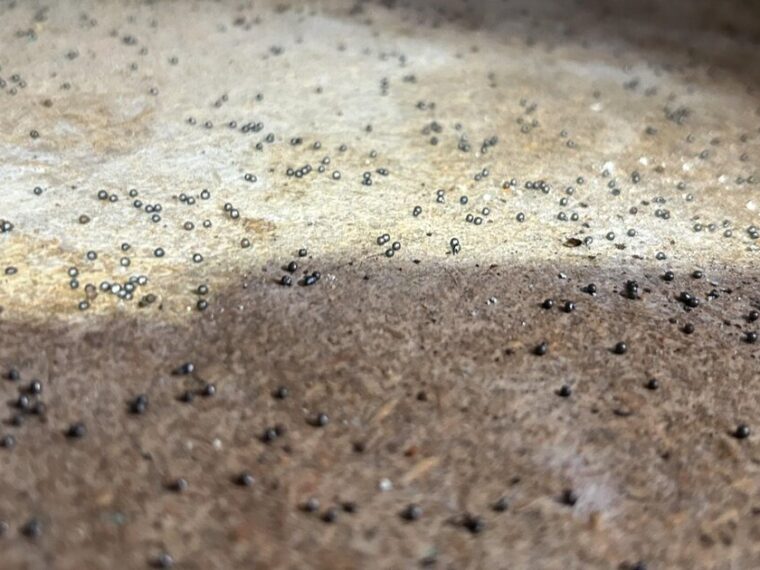Why Are Tiny Metal Balls Showing Up Under Your Kitchen Sink?
You’re tidying up under your kitchen sink when something catches your eye — a handful of tiny metal balls scattered on the cabinet floor. They aren’t perfectly round, but close enough. Some are shiny; others have a slight rust tinge. Your first thought might be, “Where on earth are these little metal spheres coming from?”
The answer may surprise you: your pull-out kitchen faucet. Yes, that sleek faucet that you use every day may be silently leaving a trail of metal beads behind. But why? And what exactly are these balls doing under your sink?
The Mystery of Faucet Weights
To understand the source of these metal balls, you need to know a little bit about how your pull-out or pull-down kitchen faucet works. These faucets have hoses that extend and retract to give you more flexibility when washing dishes or rinsing the sink. To help the hose slide back smoothly and without sagging or kinking, manufacturers install a counterweight on the hose.
This weight is often a metal or plastic casing filled with small metal balls or shot. These balls act like a dense filler, providing the necessary weight to pull the hose back into place after use. The weight must be heavy enough to retract the hose but light enough not to cause damage or undue strain on the faucet.
Over time, the weight casing can suffer wear and tear. The hose might be pulled excessively or the casing material might degrade, crack, or break open. When this happens, the tiny metal balls inside spill out and settle in the cabinet floor beneath your sink, creating that mysterious cluster of metal spheres.
Why Does This Happen?
Several factors can contribute to the metal balls escaping from their housing:
- Frequent Use: The more you pull and retract the hose, the more stress you place on the faucet weight casing.
- Material Fatigue: Plastic casings may crack over time due to constant flexing and exposure to moisture and temperature changes under the sink.
- Improper Installation or Size: If the weight is not properly sized or installed, it might move excessively and wear through its casing.
- Accidental Damage: If you or a plumber accidentally hit or dislodged the weight during sink maintenance, the casing could be compromised.
Because these small metal balls are often made from materials like steel or lead shot, they can corrode or rust over time, especially in damp environments like under a sink, making them more noticeable.
How to Check if This is the Problem
Wondering if your faucet weight is the culprit? Here’s a simple step-by-step process to find out:
- Open the Cabinet: Remove any stored items and use a flashlight to peer inside.
- Locate the Hose: Find the flexible hose attached to your pull-out or pull-down faucet. Follow it down to where it disappears into the plumbing.
- Find the Weight: On the hose, about halfway down or near the bend, you’ll see the weight. It may be a metal or plastic oval or rectangular piece clamped or snapped around the hose.
- Inspect the Weight: Look carefully for cracks, splits, or pieces missing. If you see any damage, that’s a sign the metal balls may be leaking.
- Collect Loose Balls: If there are any loose balls around, gently scoop them up to prevent them from entering your plumbing.
If the weight is intact and you’re still finding metal balls, the source may be elsewhere.
What If It’s Not the Faucet Weight?
While faucet weights are the most common source of these mysterious metal balls, other kitchen components might be responsible:
- Dishwasher Components: Some dishwashers contain small metal ball bearings or parts in their mechanisms. If a dishwasher is leaking or malfunctioning, tiny metal pieces could fall under the sink.
- Garbage Disposal: The internal grinding elements of garbage disposals can wear down. Although they are usually made of larger parts, worn metal fragments can sometimes accumulate, resembling small balls.
- Water Filter Systems: Some under-sink water filters use small metal balls or mesh materials. Faulty filters or housings could leak these parts.
- Old Plumbing Parts: Corroded valves, joints, or connectors might degrade, causing metallic debris to drop beneath your sink.
If you’re unsure, consulting a plumber or appliance technician can help identify the source and recommend repairs.
Should You Be Worried About These Metal Balls?
Generally, finding these metal balls under your sink is not a cause for alarm. They don’t pose a health hazard and won’t damage your plumbing if removed promptly. However, ignoring the problem might lead to:
- More Severe Damage: If the faucet weight casing is broken, it might affect hose retraction or damage the hose itself.
- Plumbing Blockages: Although rare, metal balls could enter the drainage system and cause minor blockages.
- Corrosion: Rusting balls could stain the cabinet or floor of your sink area.
Taking care of the problem quickly will prevent it from escalating into a more complicated repair.
How to Fix the Faucet Weight Issue
If you find that your faucet weight is the source, fixing it is straightforward:
- Purchase a Replacement Weight: These are inexpensive and widely available at hardware stores or online. Some manufacturers sell specific weights compatible with their faucet models.
- Remove the Old Weight: Gently detach the old, damaged weight from the hose. This usually involves unclipping or sliding it off.
- Install the New Weight: Position the new weight on the hose, usually halfway down or near the bend, and secure it using clips or clamps provided.
- Test the Hose: Pull the faucet hose out and let it retract several times to ensure smooth operation.
If you’re uncomfortable doing this yourself, a plumber or handyman can easily replace the weight for you.
Preventing the Problem from Returning
Regular maintenance and inspection are key to preventing metal balls from reappearing under your sink:
- Check the Faucet Weight Annually: Make it a habit to inspect the weight casing for signs of wear or damage.
- Avoid Excessive Pulling: Don’t yank the faucet hose beyond its intended reach or force it back.
- Keep the Under-Sink Area Dry: Moisture accelerates corrosion and material fatigue, so fix leaks promptly and use waterproof liners if necessary.
- Replace Aging Faucets: If your faucet is very old or frequently problematic, consider upgrading to a newer model with improved mechanisms.
By staying proactive, you can avoid surprises and keep your kitchen running smoothly.
What About Environmental Impact?
Some of these tiny metal balls are made from lead or other heavy metals, which can be harmful if released into the environment. When they spill and rust under your sink, they can eventually leach into water or soil if improperly disposed of.
Important: Collect and dispose of the balls safely. Do not rinse them down the drain or throw them in the regular trash without checking local hazardous waste regulations.
Many hardware stores or municipal waste centers accept lead and metal waste for proper recycling or disposal. Taking this small step helps protect your home and the environment.
Real-Life Stories from Reddit and Beyond
Reddit and other forums abound with curious homeowners sharing their discoveries of these mysterious metal balls:
- One user posted photos of rusty balls under their sink, only to find their faucet weight casing was completely split open.
- Another shared how replacing the weight fixed a frustrating faucet hose retraction issue.
- A few others reported similar balls near their garbage disposals or dishwasher, highlighting the importance of checking all appliances.
These anecdotes reassure many readers that this is a common, manageable household quirk, not an ominous sign.
When to Call a Professional
While fixing faucet weights is often a DIY-friendly task, some situations call for professional help:
- If you can’t locate the source of the balls: A plumber can inspect plumbing and appliances for hidden damage.
- If your faucet hose isn’t retracting properly: The problem may be more complex than just the weight.
- If metal debris is clogging drains or causing water flow issues: Professionals have tools to clear and inspect pipes.
- If you detect leaks or water damage: Early intervention prevents costly repairs.
In these cases, investing in expert advice can save time and avoid frustration.
Final Thoughts: A Small Mystery with a Simple Solution
Finding tiny metal balls under your kitchen sink can seem like an odd or even alarming discovery. But as it turns out, this is a surprisingly common and usually harmless phenomenon linked to the clever engineering of pull-out kitchen faucets.
By understanding the role of the faucet weight and knowing how to inspect and replace it, you can solve the mystery quickly and keep your kitchen clean and functioning well. And if it’s something else — dishwasher parts or garbage disposal components — you now know where to look.
This little plumbing puzzle is a reminder that even the most mundane household spaces hide fascinating stories of design, wear, and everyday magic. So next time you clean under your sink, you might just discover one of these tiny metal clues and become the detective of your own kitchen.





